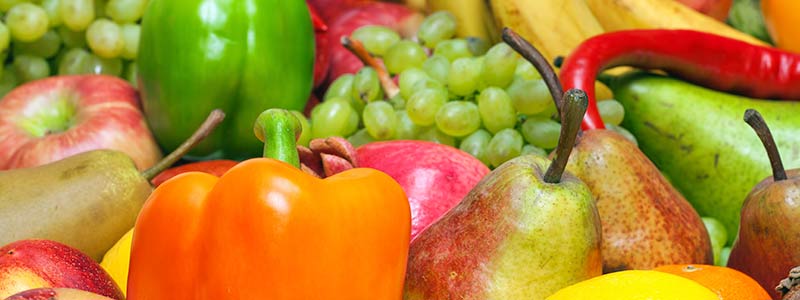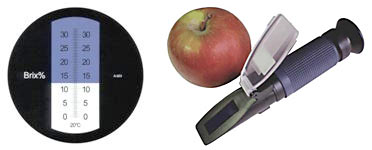Nutrient Density

Brix is a refractometer reading indicating the level of dissolved solids (mostly sugars and carbohydrates) contained in the juice being measured. The higher the brix reading the higher the sugars, mineral levels, specific gravity and true protein levels. This adds up to a sweeter tasting, more minerally nutritious food/feed with a lower nitrate and water content and better storage characteristics (less rotting). High Brix crops will produce more animal contentment and be more resistant to insects and diseases, resulting in decreased insecticide usage. Crops with a higher sugar content/brix reading will have a lower freezing point and be less prone to frost damage. A bite of a 16 brix Bell pepper from a PA grower tasted sweet, almost like eating an apple. A bite from a 4 Brix bell pepper tastes somewhat bitter. Four brix string beans need sugar added to make them taste good enough for kids to eat yet four to five Brix vegetables are typical at your local supermarket.
Refractometer

The refractometer is used in agriculture to measure the sugar content of plant juices. Apples and many other crops are often bought or sold by Brix levels. Biological growers use the refractometer to monitor their progress toward improving soil and crop response via testing the plant sap. A refractometer is easily carried in a pocket and the grower uses a garlic press to squeeze plant juice out of the leaves or stalk onto the refractometer prism. Looking through the eyepiece a grower can see the results as a horizontal line delineating the brix reading.
The refractometer can be helpful in evaluating progress. IF the line dividing the two fields is murky, it’s considered good as it indicates a more alkaline condition. A line as shown above, although the brix reading is quite good, is considered poor because the calcium level is poor. A general rule is: the higher the brix the healthier the plant. It’s also good to measure sap pH, since low pH and low brix indicate a potassium deficiency while low pH and good brix indicate a calcium deficiency. Ideally you would also measure the nitrate and potassium levels – they should be equal.
Brix
Brix is the refractometer reading indicating the percentage dissolved solids (mostly sugar and carbohydrates) contained in the juice being measured. The higher the brix reading the better the health and expression of the plant’s genetic potential. Experience has shown that low brix crops attract insects and disease. As the brix levels go up, everything about the crop seems to improve e.g. insect and disease resistance, mineral content and/or test weight of the plant, feed value, and taste.
Refractive Index of Crop Juices Calibrated in Brix
| FRUITS | Poor | Excellent |
| Apples | 6 | 18 |
| Avocadoes | 4 | 10 |
| Bananas | 8 | 14 |
| Cantaloupe | 8 | 16 |
| Casaba | 8 | 14 |
| Cherries, sweet | 6 | 26 |
| Cherries, tart | 6 | 18 |
| Coconut | 8 | 14 |
| Grapes | 8 | 24 |
| Grapefruit | 6 | 18 |
| Honeydew | 8 | 14 |
| Kumquat | 4 | 10 |
| Lemon | 4 | 12 |
| Lime | 4 | 12 |
| Mango | 4 | 14 |
| Orange | 6 | 20 |
| Papaya | 6 | 22 |
| Peach | 6 | 18 |
| Pear | 6 | 14 |
| Pineapple | 12 | 22 |
| Raisin | 60 | 80 |
| Raspberry | 6 | 14 |
| Strawberry | 6 | 16 |
| Watermelon | 8 | 16 |
| GRASSES | Poor | Excellent |
| Alfalfa | 2 | 8 |
| Cotton | 2 | 12 |
| Grains | 4 | 12 |
| Rice | 6 | 12 |
| Soybeans | 6 | 12 |
| VEGETABLES | Poor | Excellent |
| Asparagus | 2 | 8 |
| Beets | 2 | 12 |
| Bell pepper | 4 | 12 |
| Broccoli | 6 | 12 |
| Cabbage | 6 | 12 |
| Carrot | 4 | 18 |
| Cauliflower | 4 | 10 |
| Celery | 4 | 12 |
| Corn Stalk | 4 | 20 |
| Cow Pea | 4 | 12 |
| Endive | 4 | 10 |
| English Pea | 4 | 10 |
| Escarole | 4 | 10 |
| Field Corn | 6 | 18 |
| Field Pea | 4 | 12 |
| Green Bean | 4 | 10 |
| Hot Pepper | 4 | 10 |
| Kohlrabi | 6 | 12 |
| Lettuce | 4 | 10 |
| Onion | 4 | 10 |
| Parsley | 4 | 10 |
| Peanut | 4 | 10 |
| Potatoes, Iris | 3 | 7 |
| Potatoes, Red | 3 | 7 |
| Romaine | 4 | 10 |
| Rutabagas | 4 | 12 |
| Sorghum | 6 | 30 |
| Squash | 6 | 12 |
| Sweet Corn | 6 | 24 |
| Sweet Potatoes | 6 | 14 |
| Tomatoes | 4 | 12 |
| Turnip | 4 | 10 |
